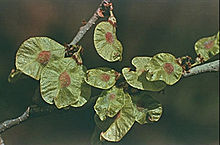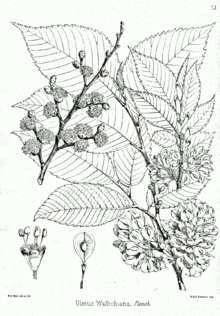Elm
![]()
Elm is a redirect to this article. For other meanings, see elm (disambiguation).
![]()
This article is about the plant genus. For other meanings, see elms (disambiguation).
The elms (Ulmus), also known as elm trees, rustic elms or moss elms, are a genus of plants in the elm family (Ulmaceae). In Central Europe, there are three species of elm, the field elm and the mountain elm. Dutch elm disease threatens to wipe out the Central European elm species. In the Netherlands, resistant varieties have been bred, but the drastic disease-related decline represents an extreme loss in terms of population genetics.
Description
Appearance
The elm species are deciduous or deciduous trees or shrubs that reach heights of up to 35 metres. Some branches have the botanically rather rare cork-wing bark, which is also found on the spindle tree (Euonymus). They are never armed with spines or thorns. The buds can be hairy.
Root
Elm species have a taproot system when young. With age, a sinker root system develops with a tendency towards a heart root (many sinkers from shallow to obliquely sweeping main roots). Even on temporary wet soils, elms form a deep root network, which is therefore extraordinarily stable.
Leaves
The alternate stem leaves are arranged in two rows on the twig and are divided into petiole and leaf blade. The simple, asymmetrical leaf blades are broadly obovate or roundish with single or double serrated leaf margins. They are pinnately veined and each lateral vein ends in a "leaf tooth". They are often three-pointed and are therefore often confused with the hazel. All three Central European elm species are easily recognized by their leaves, one half of which is always larger and unequally set at the base of the petiole. There are two membranous stipules; they fall off relatively early and leave a short stigma on both sides of the leaf base.
Inflorescences and flowers
The flowers, which usually appear in spring (before the leaves in deciduous species), are arranged with two membranous bracts in small, clustered, racemose or cymose inflorescences and are often already fully formed in early summer. The short pedicel is usually hairy (long pedunculate in the case of the fluttering elm). The flowers are usually hermaphrodite and have a simple perianth. The four to nine petals are inconspicuously coloured and bell-shaped. There are as many stamens as there are petals. The stamens are flat. The usually very short style ends in a two-branched, hairy stigma.
Fruits, seeds and seedlings
A flat nut fruit is formed, which has a broad-ovate to roundish, membranous wing all around (such fruits are called samara) and on which the stigma is still visible. There is no endosperm present. The fruits are spread by the wind. The seeds can germinate for only a few days. Sown immediately after ripening, they germinate after two to three weeks. The cotyledons are flat to more or less convex.
The chromosome base numbers are mostly x = 14.

Fossil leaf of Ulmus fischeri, a tertiary elm species

The European elm (Ulmus laevis) is the only tree species in Central Europe that can form board roots.

Fruits of Ulmus rubra

Alternate and two-rowed elm leaves

Illustration of Ulmus wallichiana
Dissemination History
Fossil evidence of elms dates back to the Tertiary period. Their increased occurrence 10 million years ago, for example in sediments of the Lower Rhine Bight, indicates a slow cooling of the subtropical climate in the Rhineland. A decline of elms can be observed by pollen analysis already in the Atlantic, whether it is due to disease or anthropogenic is controversial.
Questions and Answers
Q: What type of tree is an Elm?
A: Elms are deciduous and semi-deciduous trees.
Q: Where are Elms found?
A: Elms are found throughout the Northern Hemisphere from Siberia to Indonesia, Mexico to Japan.
Q: What kind of leaves do Elms have?
A: Elms have alternate, simple, single- or doubly-serrate leaves that are usually asymmetric at the base and sharply pointed at the tip.
Q: Are Elms hermaphroditic?
A: Yes, Elms are hermaphroditic, having perfect flowers.
Q: How are Elms pollinated?
A: Elms are wind-pollinated.
Q: What is the fruit of an Elm?
A: The fruit of an Elm is a round samara.
Q: How long does it take for Elms to grow to maturity?
A: Elms take many decades to grow to maturity.
Search within the encyclopedia